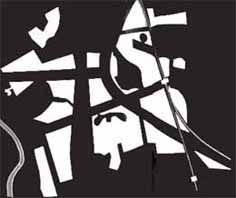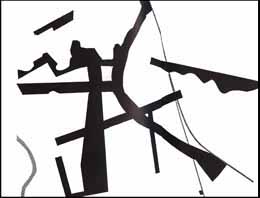Strategies
for responding to complex urban situations
|
|

Ville Nouvelle Melun-Sénat, 1987
Diagram:
minimum drawing to explain a concept. But also to generate concepts, instrument
in the design process. Visual and verbal formulations, for an inventory of the
involved aspects. Graphical representation of abstract data and structural characteristics.
Every information can generate a theme or concept. Diagrams convert data into
phenomenon, conceptualizing through the use of images, models and signs. The situations
are understood retroactively from conceptual advances.
Question: what map and how? Mechanisms: selection, reduction and simplification. Visualization of the data as point of departure to a concept. Graphic representation renders data manipulable as material for analytical models that can be represented without a design. Comparable diagrammatic representation of the existing situation and the hypotheses.
OMA’s analytical explorations using diagrams aim at to disclose the invisible structures of contemporary city. They suppress the border between analysis of the data and conception of the project. Koolhaas uses figures as analogies of operating mechanisms. It is not representation, but operational principle of the components of a project. It is this organizing potential (not visual) that makes of the figure a diagram.
The diagram is an instantaneous overview of a complex of factors. An instrument to visualize data, thus rendering them manipulable and designable. Schematization: the separate components (data, phenomenon, project) are examined in terms of new mutual relationships. Design is specific for the context, but at the same time it introduces new typologies.
Grid: identification of the territorial (contours, infrastructure) and programmatic (repetitive spaces, services, nodes of intensity) regularities. To blow up the potentialities of the program, detaching the functional incompatibilities and contradictions. Spaces saturated with lines and intentions, allowing formal interventions and chance. Grid is an organizational principle, a mode to produce new spatial questions. It is the perfect frame for instability to unfold itself with direction.
The principle of the band: they emerge of the deconstruction of continuous urban structures. They correspond to systems of urban fragmentation (enclaves and autonomous constructions).
Programmatic instability - designs that allow programmatic alterations without loss of cohesion. A configuration capable to integrate components marked by instability. A structure associated with the diversity of mutant activities. How to orchestrate in a metropolitan field a dynamic coexistence of different activities and to generate, through its mutual interferences, new events? Tactics of layering: maximum of permeability of each programmatic band.
Congestion - to explore all the possibilities of confrontation and overlapping to affirm a density of occupation without constructed architecture. Not design, but strategy: a method that matches specificity architectural and programmatic undetermination. Metropolitan situations that have to accommodate heterogeneous programs because in them emptiness is the dominant dimension.
To keep emptiness. To take urbanism’s position of weakness as premise. Inventory of the situation and analysis by reverse logic: where not to construct. Figures of void space. A system of bands, of linear voids, is inscribed on the site. Instead of a city organized through its build form, a formless configuration, defined by this system of emptinesses. The bands define an archipelago of residues, with variable relations with infrastructure. Counterforms of the voids, they can accommodate different programs, with maximum autonomy.
To invent programs: maximum use of the existing infrastructure. Programs continuously inserted in an informal and amorphous mode. Project continuous and without form, takes the site as a programmatic larva. Supporting the biggest possible number of events with the lesser amount of definitions. Minimum containment of mass to generate the biggest possible density with the lesser permanence.
Today, Koolhaas urban research is distinguished of design research. It is more foundational urban research, without the specific commitments with the construction of architectural structures. Photo collages, statistics and texts. Conceptual definitions based on fieldwork. Interrelated studies attempting to give a vision of the emerging conditions. Continuous processes of measurement and regulation. New concepts aiming at a new vocabulary and a new framework.

